Semana Criolla, aka Semana de Turismo, aka Semana Santa is the last big holiday stand before the year "really begins". January, and February is holiday season, and everybody takes vacations. March is kind of a lame month, classes start, kids go to school, and then again in Semana de Turismo everybody is on vacation again. This is specially true for those working for the state. Public offices usually take the whole week, while private companies, only take friday, but lots of people (like me :), take thursday off too.
The saying in Uruguay, is "the year begins after Semana de Turismo". So much for hardworking Uruguay.
Semana Santa is big in internal tourism, families go camping, to santa teresa for example, and a couple of cool events take place in Uruguay:
La fiesta de la cerveza in Paysandu
Uruguay's beerfest in Paysandu. This is a whole week party, where it gets crammed with (drunk?) teenagers. Never been to la fiesta de la cerveza myself, but they say it's fun, maybe worthy of E! Wild on... I wouldn't know, anyone?
On a sad note, this year's party will be shortened, since the bridges with Argentina are blocked, and the usual 20.000 young argentineans that come to party won't be present.
Semana Criolla en la Rural del Prado
La Semana Criolla en la Rural del Prado, a once in a year event, where country customs get celebrated, featuring jineteadas and payadas tournaments.This is Uruguay posted a nice article about Semana Criolla in Uruguay, including a jineteada video. (Chuck also blogs on the topic).
Felices pascuas to everyone! (happy eastern!)...
Thursday, April 05, 2007
Semana Criolla, Beerfest in Paysandu
Posted by
gabouy
at
8:21 AM
8
comments
![]()
Labels: Customs
Wednesday, March 21, 2007
Rifa Arquitectura, around the world in seven months
Architecture and travelling, are not necessarily synonyms, right? Well, in Uruguay they are, sort of. Every year a group of more than 100 students of the Architecture Faculty, of the University of the Republic get to travel around the globe for seven months or so. The best of it, is that this is willingly financed by Uruguayans. You are thinking taxes, or university support, right? Well, not exactly. Actually they organize the biggest fundraiser raffle in the country.

Everybody in Uruguay knows someone who’s either studying architecture, or who has a son, or sister who’s doing it, and it’s like the right thing to do in Uruguay to buy at least one ticket to support the lazy bum to travel the world, meet interesting people, learn and maybe some day… design houses?

Tickets can be paid in affordable ten bucks installments, for a period of one year, and the prizes are really, really good. Like houses, apartments, cars, laptops, trips, etc. There are 10 sorting events (is that the term?) along the year, all of them with a very attractive pool of prizes.
In theory those who travel are graduate students, in practice they travel before finishing studies, usually a couple of years before, and since the career takes so long (7 in theory, 11 average) ages of those travelling vary (thanks ana for the correction). They are allowed to take someone as travel partners. When they are abroad they flock in smaller groups to do parts of the trip. These groups sometimes buy vans in Europe to road trip, and after they are done they sell them.
Some of the Uruguayan architecture travellers take the trip with a, let’s say, academic attitude, they get up early, visit museums, go to conferences, and try to see and learn as much as they can. On the other hand, there’s always the nonstop partying crowd, who focus on learning the different cultures at nighttime.
This week you may see them in Plaza Cagancha, “demonstrating”, and trying to sell raffle tickets. You just can’t say no to those faces, can you?

Posted by
gabouy
at
7:38 PM
18
comments
![]()
Labels: Customs
Friday, August 25, 2006
La Noche de la Nostalgia
<<previous
next>>
 Every 25th of August Uruguay celebrates the Declaration of Independance. It's one the five non workable holidays in the year, meaning the night before it's a good time for partying, just like a friday, or saturday.
Every 25th of August Uruguay celebrates the Declaration of Independance. It's one the five non workable holidays in the year, meaning the night before it's a good time for partying, just like a friday, or saturday.
Something like twenty years ago, sponsored by a local am radio, someone invented "La Noche de la Nostalgia" (the nostalgia night), to name a party where only "old hits" would be played. This party's idea spread along the years, like a virus, and now the night of the 24th it's a national phenomenon, that's even been passed as a law (LEY N° 17.825 ????).
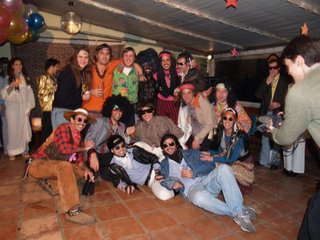 This particular night moves as many people as the night of the 25th, or 31st of december. Some even say that it beats those nights, becoming THE night of the year when most people go out partying in Uruguay. It appeals to all ages, I know some old couples that only go out dancing that night in the year. There is a great variety of things to do, parties of all types and sizes, public, and private. Some people organize thematic custom parties. It's just different.
This particular night moves as many people as the night of the 25th, or 31st of december. Some even say that it beats those nights, becoming THE night of the year when most people go out partying in Uruguay. It appeals to all ages, I know some old couples that only go out dancing that night in the year. There is a great variety of things to do, parties of all types and sizes, public, and private. Some people organize thematic custom parties. It's just different.
The whole thing is based in "the good all days" concept. The night of the 24th kinda celebrates the idea that former days of our lives will always be better than present ones, which sounds pretty much like a tango, if you think about it (todo tiempo pasado fue mejor). Here in Uruguay, nostalgia is culture.
It's speaks a lot about Uruguay's idiosyncracy. It's the yearly instance to remind us that we were once the champions of the world, we were called the switzerland of south america, and so on and so forth.
When it started old hits were music of the sixties and seventies, and now oldies mean eighties and ninties hits. If you go out you may listen to stuff like: Barry White, Barry Manilow, Air Supply, Billy Joel, Aha, Sui Generis, Los Shakers, Billy Idol, Queen, Beatles, Phil Collins, Michael Jackson, The Police, The Ramones, etc.
There are also anti nostalgia movements, which organize rave parties to celebrate all the contrary, for those that cannot bear to live in a country that tends to look backwards, or that just want something different from that night.
The stay in the mood, I leave you now with an oldie...
Posted by
gabouy
at
5:52 AM
25
comments
![]()
Labels: Customs
Friday, January 27, 2006
The longest carnival in the world has begun
<<previous
next>>
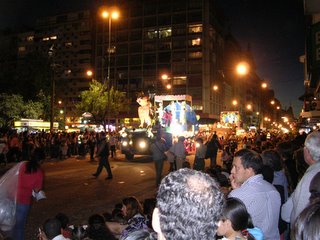
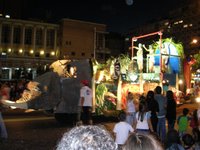 Last Thursday started Uruguay's carnival, which this year's been baptized as the longest carnival in the world. I guess, we may not have Brazilian's glamorous, most famous carnival, but we have the longest, or so they say. It goes from January’s last week until the first days of March. Uruguay's carnival actually has little or nothing to do with Brazilian’s one.
Last Thursday started Uruguay's carnival, which this year's been baptized as the longest carnival in the world. I guess, we may not have Brazilian's glamorous, most famous carnival, but we have the longest, or so they say. It goes from January’s last week until the first days of March. Uruguay's carnival actually has little or nothing to do with Brazilian’s one.
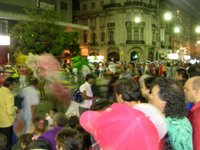 It's Uruguay biggest popular celebration; it's a strange mixture between Hispanic carnival traditions with afro rhythms, the result is something I haven’t seen elsewhere. Along the month or so it lasts a lot of shows and presentations take place starting with the initial parade in 18 de Julio the main street in Montevideo's downtown. This initial parade consists of different carnival groups called comparsas which compete for the year’s carnival prize, and walk all over 18 singing and dancing, and waving flags, and carnival symbols.
It's Uruguay biggest popular celebration; it's a strange mixture between Hispanic carnival traditions with afro rhythms, the result is something I haven’t seen elsewhere. Along the month or so it lasts a lot of shows and presentations take place starting with the initial parade in 18 de Julio the main street in Montevideo's downtown. This initial parade consists of different carnival groups called comparsas which compete for the year’s carnival prize, and walk all over 18 singing and dancing, and waving flags, and carnival symbols.
 As it was just some blocks away from my place I decided to pass by to take some pictures. For the record the previous time I'd gone to this parade I was a kid with no more than ten years, and my only and main recollection of it was about "cabezudos" (meaning bigheaded), which are guys disguised with an enormous painted "head", reaching more than 8 feet tall that approach to children to scary them at the rhythm of music. To my surprise they told me that these characters are no longer very frequent, too bad, they rocked. Well this time I also got a little scared but not because of the cabezudos, you see, every time I took out my camera I had the feeling that a lot of eyes that seemed to have escaped out of mordor where watching it and following me. Nothing happened, there was a lot of police presence but it was uncomfortable.
As it was just some blocks away from my place I decided to pass by to take some pictures. For the record the previous time I'd gone to this parade I was a kid with no more than ten years, and my only and main recollection of it was about "cabezudos" (meaning bigheaded), which are guys disguised with an enormous painted "head", reaching more than 8 feet tall that approach to children to scary them at the rhythm of music. To my surprise they told me that these characters are no longer very frequent, too bad, they rocked. Well this time I also got a little scared but not because of the cabezudos, you see, every time I took out my camera I had the feeling that a lot of eyes that seemed to have escaped out of mordor where watching it and following me. Nothing happened, there was a lot of police presence but it was uncomfortable.
I would like to say it was awesome, but it really wasn’t, the truth is that it didn’t live up to my memories. Between every comparsa you’d have to wait around twenty minutes. It disappointed me to see so much commercial propaganda in the flags, banners and carrousels of each carnival group. I felt the whole thing has gone very commercial. Even though there were a lot of cops there was still a feeling of insecurity. Next Friday is the second big parade in Uruguay’s carnival; named "Las Llamadas", it’s more typical of afro culture in Uruguay, with much more Candombe which a like and for me much more enjoyable.
 ...
...
Posted by
gabouy
at
2:35 PM
10
comments
![]()
Labels: Customs
Friday, January 06, 2006
The Wizard Kings
No, I'm not talking about some role playing game, this is about something that's still celebrated in Uruguay, which is the Three kings festivity or The Wizard kings, or as we ordinary refer to it here, "Los Reyes Magos". Named after the visitation to the Jesus child by three wise men, or three wizard kings, mentioned in the bible. It's a holiday and it's a very special morning particularly for children.
<<previous
next>>
Every January 6th children wake up early and run anxiously to the Christmas tree to find gifts placed by their shoes, does this sound weird? Tradition says that anyone who wants to be gifted by the three wizard kings must leave his or her shoes by the Christmas tree. Also a bucket with water and another one with grass must be left for the feeding of the camels, didn't i mention it?, they travel in camels. Letters are written to wizards with detailed specifications of the dreamed toys, and “unbiasedly” describing the year overall behavior.
It was funny to wake up and find the buckets moved, the grass gone, less water, irrefutable proof of the passing and existence of the three kings for every children in Uruguay. In some families with strong Spanish tradition like mine, gifts were more and better than those given at Christmas' eve, after all it had it's logic, Santa Claus is only one, these guys are three, they should try harder.
...
Posted by
gabouy
at
6:26 AM
11
comments
![]()
Labels: Customs
Saturday, December 31, 2005
Last working day, throw your calendar away
<<previous
next>>
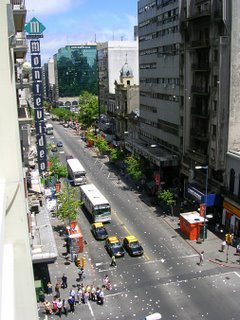
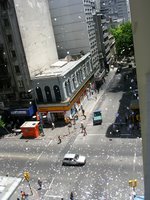 In Montevideo's downtown the last working day of the year has it's traditions. Most of the offices work until noon, the after office is at "El mercado del puerto" or ciudad vieja and around 11:30AM an unusual show starts.
In Montevideo's downtown the last working day of the year has it's traditions. Most of the offices work until noon, the after office is at "El mercado del puerto" or ciudad vieja and around 11:30AM an unusual show starts.
 People start throwing shredded paper out of the windows, and buckets of water to say goodbye to the old year. Traditionally the papers that are thrown are sheets of the old year's calendar, torn out the last working day.
People start throwing shredded paper out of the windows, and buckets of water to say goodbye to the old year. Traditionally the papers that are thrown are sheets of the old year's calendar, torn out the last working day.
 It's fun, the space between buildings gets filled with calendar sheets with every day in the almost gone year dancing in an american beauty plastic bag kind of way. At the same time people rush out of the buildings to avoid unexpected showers of the randomly falling water, and the ocasional unlucky one gets soaked. It's an unusual and funny sight.
It's fun, the space between buildings gets filled with calendar sheets with every day in the almost gone year dancing in an american beauty plastic bag kind of way. At the same time people rush out of the buildings to avoid unexpected showers of the randomly falling water, and the ocasional unlucky one gets soaked. It's an unusual and funny sight.
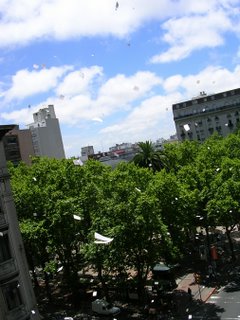 ...
...
Posted by
gabouy
at
4:39 AM
26
comments
![]()
Labels: Customs
Sunday, December 25, 2005
Christmas in Uruguay
<<previous
next>>
 First of all, there is no such a thing as white Christmas in Uruguay, for two reasons. The first one is that in this hemisphere is summer time, the second being that it never snows in Uruguay (a great deal of Uruguayans don’t know snow), so even if it were winter, it wouldn’t be white anyway. In hot summers here is more like sweating Christmas.
First of all, there is no such a thing as white Christmas in Uruguay, for two reasons. The first one is that in this hemisphere is summer time, the second being that it never snows in Uruguay (a great deal of Uruguayans don’t know snow), so even if it were winter, it wouldn’t be white anyway. In hot summers here is more like sweating Christmas.
Santa Claus here is called Papa Noel, and his associates here deliver all the Christmas presents at 12’ o clock sharp. So children expect presents to appear right away under their noses and they are a tough clientele. Yes, yes, HoHoHO! For some weird reason Santa Claus has this weird way of laughing over here too, although here is spelled more like JOJOJO ;)
There are no Christmas vacations, school period goes from March till December, school has already finished a month ago. For working guys such as myself, the 24th is workable only until noon, and the 25th is a non workable holiday. Unfortunately this year both days fell in weekend days which sucked.
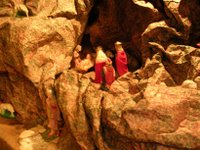 Preparations for Christmas’ eve and Christmas day include setting up your own Christmas tree. Some people like to have it natural, in such a case you have to go and get some pine tree somewhere, which is becoming uncommon. Another thing to do is to make one little holy manger usually within the fireplace, with ceramic figures, and rock paper. Some families also leave the little Jesus spot empty in the manger until Christmas day arrives.
Preparations for Christmas’ eve and Christmas day include setting up your own Christmas tree. Some people like to have it natural, in such a case you have to go and get some pine tree somewhere, which is becoming uncommon. Another thing to do is to make one little holy manger usually within the fireplace, with ceramic figures, and rock paper. Some families also leave the little Jesus spot empty in the manger until Christmas day arrives.

Christmas is celebrated typically in the following manner: families gather on a Christmas’s eve dinner, spend the evening together, until the clock ticks twelve. When Christmas day finally does arrive, everyone hugs each other, parents put up a children’s deceiving show telling them to look at some nonexistent star in the sky where Santa is supposedly coming from (here the north pole Santa’s elves factory thing is not very spread), also this scheme lends to several possible variations. While the children are looking at the sky after some decoy the other parent or some relative puts the presents beneath the Christmas tree, and shouts notifying of the sudden arrival and departure of Santa. Everyone else who is not involved in this children deceiving scheme may probably be playing with fireworks, making a lot of noise, lighting up the city, eventually getting a hand burned.

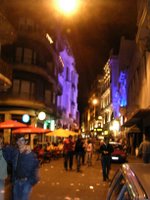 After all of this in Montevideo the two more interesting spots to be are “La Rambla” where people usually park their cars and put music real loud, dancing and drinking by the beach, or in ciudad vieja where there are a lot of pubs to hang out.
After all of this in Montevideo the two more interesting spots to be are “La Rambla” where people usually park their cars and put music real loud, dancing and drinking by the beach, or in ciudad vieja where there are a lot of pubs to hang out.
By the way... HAPPY CHRISTMAS!!! FELIZ NAVIDAD!!
...
Posted by
gabouy
at
6:54 PM
121
comments
![]()
Labels: Customs
Mercado del Puerto an uruguayan tradition
<<previous
next>>

 It’s December 24th, noon, and you are in Montevideo, Uruguay. What do you do? You go to “El Mercado del Puerto” (translated would be something like the Port’s Market). El Mercado del Puerto is a recycled market from mid 19th century which now hosts grill restaurants, serving typical Uruguayan dishes, asado and relatives. The place’s been around for about 150 years and has seen guests such as Gardel, Figari and virtually everyone who ever lived in Montevideo in the last century. It’s a very picturesque spot, it’s one of the icons of the city, and it’s a must for every tourist wandering about. The place deserves a post on its own.
It’s December 24th, noon, and you are in Montevideo, Uruguay. What do you do? You go to “El Mercado del Puerto” (translated would be something like the Port’s Market). El Mercado del Puerto is a recycled market from mid 19th century which now hosts grill restaurants, serving typical Uruguayan dishes, asado and relatives. The place’s been around for about 150 years and has seen guests such as Gardel, Figari and virtually everyone who ever lived in Montevideo in the last century. It’s a very picturesque spot, it’s one of the icons of the city, and it’s a must for every tourist wandering about. The place deserves a post on its own.
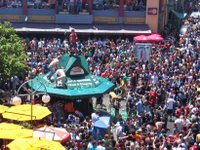 Towards the end of the year it’s the place of choice for lots of Uruguayans wishing to bid the year farewell, typically with office mates. It’s traditional to go and have lunch, and get dizzy or plain drunk on “medio y medio” (a drink made out of bubbling wine and dry white wine, medio y medio meaning half n’ half), a sweet deceiving thing that goes up ones head quickly.
Towards the end of the year it’s the place of choice for lots of Uruguayans wishing to bid the year farewell, typically with office mates. It’s traditional to go and have lunch, and get dizzy or plain drunk on “medio y medio” (a drink made out of bubbling wine and dry white wine, medio y medio meaning half n’ half), a sweet deceiving thing that goes up ones head quickly.
 The peaks of this celebrations are the 24th and the 31st when most offices work till noon and the after office traditionally is at El Mercado del Puerto, where people go to celebrate, eat, dance in the street, or just watch the live spectacle. It’s the kind of event you’d see on an E! Wild On show. There are music groups playing drums at Candombe and Samba rhythms, people spill beer and “medio y medio” over each other, (women are the most affected :) So if you go chances are that you will get wet and come back smelling, whether you drink or not. Movement starts somewhere around noon, and continues until around five.
The peaks of this celebrations are the 24th and the 31st when most offices work till noon and the after office traditionally is at El Mercado del Puerto, where people go to celebrate, eat, dance in the street, or just watch the live spectacle. It’s the kind of event you’d see on an E! Wild On show. There are music groups playing drums at Candombe and Samba rhythms, people spill beer and “medio y medio” over each other, (women are the most affected :) So if you go chances are that you will get wet and come back smelling, whether you drink or not. Movement starts somewhere around noon, and continues until around five.
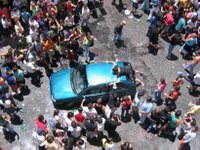 As the afternoon advances the place gets progressively crowded, noisy, wild, and even dangerous since it’s a drunken mob that we are talking about. The vibe in general is very, very good, but on a 24th or 31st the place is Armageddon, I don’t stay after three or four myself. Instead a few blocks away there’s the old city (ciudad vieja) where partying in the street continues.
As the afternoon advances the place gets progressively crowded, noisy, wild, and even dangerous since it’s a drunken mob that we are talking about. The vibe in general is very, very good, but on a 24th or 31st the place is Armageddon, I don’t stay after three or four myself. Instead a few blocks away there’s the old city (ciudad vieja) where partying in the street continues. ...
...
Posted by
gabouy
at
2:52 PM
25
comments
![]()
Labels: Customs
Tuesday, November 22, 2005
Getting a university degree in Uruguay
<<previous
next>>

 University studies in uruguay are free, there's no entrance or monthly fee. If you have your high school studies finished it's ok to register, attend courses and take exams. A long time ago in galaxy far away this made uruguay stand out from other south american countries and people would come to get their medicine degree from places like colombia, bolivia and paraguay, mostly paraguay. There is no career quota and the trendy careers get crowded, actually today all careers get crowded :( There are also private universities, which are about ten or fifteen years old, but they do not cover all careers, and still the public degrees remain the most valued at least in the national job market (IMHO this is wearing off).
University studies in uruguay are free, there's no entrance or monthly fee. If you have your high school studies finished it's ok to register, attend courses and take exams. A long time ago in galaxy far away this made uruguay stand out from other south american countries and people would come to get their medicine degree from places like colombia, bolivia and paraguay, mostly paraguay. There is no career quota and the trendy careers get crowded, actually today all careers get crowded :( There are also private universities, which are about ten or fifteen years old, but they do not cover all careers, and still the public degrees remain the most valued at least in the national job market (IMHO this is wearing off).
Being a poor country and all, infrastructure it's not what it used to be, worst of all it's not what it ought to be. I've heard that a couple years ago psychology classes where given on a church (the irony is great :), and the place used as classroom would leak on rainy days. Today classes get crowed, it's rather normal to see people arrive early to classes and make "reservations" for friends, by leaving notebooks on the classroom seats, or using clothes or whatever.
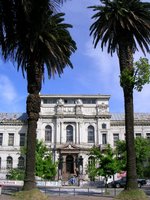 The notion of university campus does not exist, the university of the republic has specialized schools for the different careers distributed in the capital city montevideo. This forces people living outside the capital travel frequently or move into the capital. About half of the university students are'nt from the capital, and are informally called "canarios" by the inhabitants of montevideo (i remember one graffiti on a classroom desk saying "canarios go home" ;)
The notion of university campus does not exist, the university of the republic has specialized schools for the different careers distributed in the capital city montevideo. This forces people living outside the capital travel frequently or move into the capital. About half of the university students are'nt from the capital, and are informally called "canarios" by the inhabitants of montevideo (i remember one graffiti on a classroom desk saying "canarios go home" ;)
One cool thing about university in uruguay is that it's a self managed, state independent entity, with it's own government formed by one third of representatives of the students, one thirds of the teachers, and one thirds of professionals, former students.
Due to the economic situation in uruguay the usual thing is for students to study and work part or full time, which leads to an average of more than eight years for people to get their diplomas.
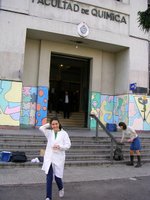 Whenever someone gets a college degree tradition in uruguay says he or she must be exposed to humiliations of sorts. If you are male, forced head shaving it's mandatory, and no matter your sex you get the usual flour bath, with eggs (preferably rotten) crashed in your head, along with yerba (the stuff for mate, remember?), and pretty much whatever the imagination of you college mates dictates. Some schools have more specialized traditions, like in architecture they new architect must be thrown to the pond of the mutant fishes (that eat cigarettes), in the chemics school they throw to the victim radioactive components with smells and colors that won't go away for days. In engineering the brand new engineer must sit on a stone seat, mortally cursed for any nonengineer.
Whenever someone gets a college degree tradition in uruguay says he or she must be exposed to humiliations of sorts. If you are male, forced head shaving it's mandatory, and no matter your sex you get the usual flour bath, with eggs (preferably rotten) crashed in your head, along with yerba (the stuff for mate, remember?), and pretty much whatever the imagination of you college mates dictates. Some schools have more specialized traditions, like in architecture they new architect must be thrown to the pond of the mutant fishes (that eat cigarettes), in the chemics school they throw to the victim radioactive components with smells and colors that won't go away for days. In engineering the brand new engineer must sit on a stone seat, mortally cursed for any nonengineer.
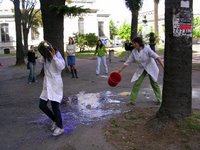 ...
...
Posted by
gabouy
at
4:45 PM
16
comments
![]()
Labels: Customs
Sunday, November 13, 2005
Tristan Narvaja, the largest uruguayan flea market
<<previous
next>>
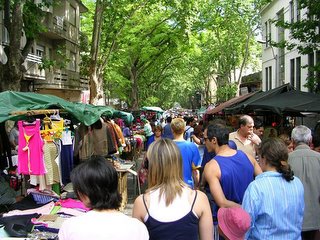
 Every sunday morning takes place the largest flea market in Uruguay, named after the street where it's located.La feria de tristan narvaja is the kinda place where you can find everything, ranging from tarantula like spiders, parrots, old comic magazines, groceries, books, arts & crafts, old vinyl records, old tv and radio sets, antiques, to the latest pirate piece of software. I guess, "eclectic" is the most suitable word for the place.
Every sunday morning takes place the largest flea market in Uruguay, named after the street where it's located.La feria de tristan narvaja is the kinda place where you can find everything, ranging from tarantula like spiders, parrots, old comic magazines, groceries, books, arts & crafts, old vinyl records, old tv and radio sets, antiques, to the latest pirate piece of software. I guess, "eclectic" is the most suitable word for the place.
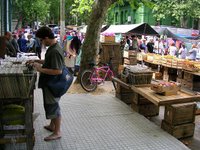 It's the land of the collectionist and the pick-pocketer, a place where you can find the neighbor buying the week's stock of groceries, the ocassional madman shouting, the street beggar begging, and the reseller looking for some undervalued item. A human zoo of sorts, a uruguayan gallery of sights, sounds and scents. It's in some way the negative of a shopping center.
It's the land of the collectionist and the pick-pocketer, a place where you can find the neighbor buying the week's stock of groceries, the ocassional madman shouting, the street beggar begging, and the reseller looking for some undervalued item. A human zoo of sorts, a uruguayan gallery of sights, sounds and scents. It's in some way the negative of a shopping center.
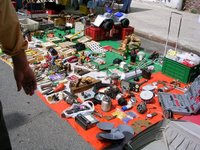 The market is placed all along the tristan narvaja street, which is about one kilometer, and extends to every crossing and paralell street. While the backbone of the market takes place in tristan narvaja st, it is in the periphery where it is more likely to find hidden "treasures", laid on blankets on the street. It is also in the periphery where is less secure, and is a more fertile ground for street scams.
The market is placed all along the tristan narvaja street, which is about one kilometer, and extends to every crossing and paralell street. While the backbone of the market takes place in tristan narvaja st, it is in the periphery where it is more likely to find hidden "treasures", laid on blankets on the street. It is also in the periphery where is less secure, and is a more fertile ground for street scams.
 There is even one uruguayan urban myth that talks about one "torres garcia", a painting from one of the most famous uruguayan paintors was actually found and bought here for nothing. There is also another myth about an stradivarius being found here, but the latter I find harder to believe.
There is even one uruguayan urban myth that talks about one "torres garcia", a painting from one of the most famous uruguayan paintors was actually found and bought here for nothing. There is also another myth about an stradivarius being found here, but the latter I find harder to believe.
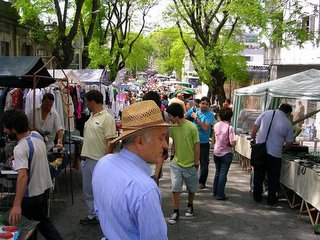
...
Posted by
gabouy
at
12:03 PM
139
comments
![]()
Tuesday, November 08, 2005
Truco, the most uruguayan of card games
<<previous
next>>

The most emblematically uruguayan card game is called "truco", or "uruguayan truco" to be accurate. Truco means something like trick, as in: to trick someone in doing something. It's played by four or six players, in two teams of 2, or three players, with a spanish deck without the 8's, the 9's and the wildcards.
 Three cards are handed to each player, and one card is left upside down under the deck, this card is called "la muestra", which would be something like "the shown" (don't worry; it makes as much sense in english as it does in spanish ;). Every player plays one card at a time in three "rounds". The game is based on betting points on each hand, and the team who wins two rounds out of three wins the hand and the pot of points of that hand (well, sort of, it's a bit more complex than that). The team to reach 40 points first is declared the happy winner.
Three cards are handed to each player, and one card is left upside down under the deck, this card is called "la muestra", which would be something like "the shown" (don't worry; it makes as much sense in english as it does in spanish ;). Every player plays one card at a time in three "rounds". The game is based on betting points on each hand, and the team who wins two rounds out of three wins the hand and the pot of points of that hand (well, sort of, it's a bit more complex than that). The team to reach 40 points first is declared the happy winner.
Every card in the game has a value assigned to it, and one of the cool things about truco, is that most of the cards in the deck have one or another value depending on the "shown". All cards are given a value, some cards don't depend on "the shown", but the most valuables are the ones which do depend. This set of most valuable cards is called "las piezas" (the pieces). Remember I said it was played in teams, well, one of the funniest things about truco is that there is a language of facial signs meant to communicate what cards you have to your team mates. And part of the game skill is to communicate the cards you have without being watched by your opponents, you will try to cover your face with your arms, or wait till no one’s watching to make the signs.
Good players, and good teams are those who make the most out of the cards they have, and when they don’t really have valuable cards, they act, and trick the other team into believing that they do, and when they do have good cards they act as if they didn't laying out a trap for the other team to fall into. So there's a lot of acting involved, I guess while in poker is more natural to stay calm, and not to show emotions whatever is your hand, in truco there's a lot of team acting and outspoken speculation of the cards the other team might have. Add a bit of alcohol to the situation and you will get Shakespeare like interpretations.
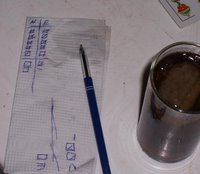 The betting mechanism is based on a set of reserved words: "truco", "retruco", "vale cuatro" to raise the bet one point, and "envido" to make a special bet, or "flor" if you have a certain combination of cards. All these reserved words you just can't use them in your conversation, which sometimes does happen, being the name of the game one of the reserved words, if you do say any of them your opponents may hold the bet as made, and you will have to prove the worth of your hand of cards. One very common act is to say one reserved word and pretend it to have been a mistake, good acting is required. Another thing that is cool is to say some kind of poetic verse ending with the reserved word, to anger the opponents, typically used with the "flor" (flower), which informs the opponent team that you have a certain combination of cards that entitle you to 3 points per se.
The betting mechanism is based on a set of reserved words: "truco", "retruco", "vale cuatro" to raise the bet one point, and "envido" to make a special bet, or "flor" if you have a certain combination of cards. All these reserved words you just can't use them in your conversation, which sometimes does happen, being the name of the game one of the reserved words, if you do say any of them your opponents may hold the bet as made, and you will have to prove the worth of your hand of cards. One very common act is to say one reserved word and pretend it to have been a mistake, good acting is required. Another thing that is cool is to say some kind of poetic verse ending with the reserved word, to anger the opponents, typically used with the "flor" (flower), which informs the opponent team that you have a certain combination of cards that entitle you to 3 points per se.
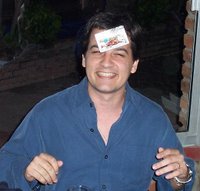 There are a lot of subtleties to the game, like the fact that you can say any of the reserved words if you place your hand or one finger on top of the deck (for the deck not to listen), or traditions like carrying the score on a napking using squares, where each line is a point, or carrying the score with beans, and using beans to represent the amount of points in the pot of the current hand, or like licking your fingers, and wetting your forehead to place one card on it when you won the hand with the most valuable card, and fooled the other team into believing you were out of good cards, like some kind of "in your face" sort of thing.
There are a lot of subtleties to the game, like the fact that you can say any of the reserved words if you place your hand or one finger on top of the deck (for the deck not to listen), or traditions like carrying the score on a napking using squares, where each line is a point, or carrying the score with beans, and using beans to represent the amount of points in the pot of the current hand, or like licking your fingers, and wetting your forehead to place one card on it when you won the hand with the most valuable card, and fooled the other team into believing you were out of good cards, like some kind of "in your face" sort of thing.
The game is played also in argentina, the uruguyan version of the game is called uruguayan truco, or truco oriental, while the argentinian version is called "truco ciego" or blind truco, since they dont play with "la muestra", much simpler, all cards have the same value always, also much boring if you ask me.
...
Posted by
gabouy
at
4:54 AM
18
comments
![]()
Labels: Customs
Wednesday, November 02, 2005
Fiesta X
<<previous
next>>
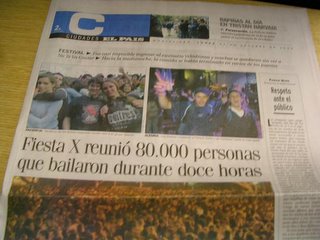
Last saturday took place one of the national megapartys, called "La Fiesta X" (the X party), which summoned around 80.000 persons, or so they say. When you live in a country of 3 millions people, believe me, that's a lot! You had in one spot in the city every uruguayan music band of every genre and style possible playing on several stages along with some really big tents for electronic music. It must have been a human zoo of sorts. Check out the complete list bands that were there.
I wasnt there but the word is that the organization turned out to be kinda crappy, food stands ran out of food around 11pm (here in uruguay, partying is something that goes on until 5-6am). And they were very short on chemical toilets, bad for the women, huge queues.
...
Posted by
gabouy
at
2:26 AM
10
comments
![]()
Labels: Customs
Sunday, October 16, 2005
Food, bakery
As americans have donuts, and french have croissants, we have bizcochos. Lazy cops here dont eat donuts, no, they eat bizcochos. They are made mainly out of flour and grease. There are salad and sweet ones, the salad ones are filled with cheese, or bacon, and the sweet ones with...guess, yes, dulce de leche, or dulce de membrillo. It's typical to have them with breakfast or tea (mate actually). You buy them by the kilo, and you usually eat it with friends or family. I guess it's not very healthy but tasty ;)
<<previous
next>>

These ones are called "Alfajores de maizcena", like little cakes, with a thick layer of "dulce de leche" in the middle, and coconout in the borders, if you like really sweet stuff (which i do) you can't miss them. Enter into any baker's store (panaderia) and pronounce: "alphajores", then thank me.
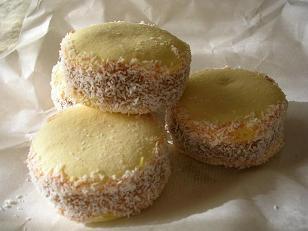
These ones are called "ojitos" (little eyes), dont know how they make them, dont really care, I think it involves grease and some sweet red stuff that goes in the middle, im crazy'bout them, always been.
 ...
...
Posted by
gabouy
at
8:06 PM
51
comments
![]()
Food, dulce de leche
<<previous
next>>

Dulce de leche is a creme, made with milk and sugar (hence the name), with kinda caramel flavor, but better ;) You can find it everywhere in Uruguay's sweet food, cakes, everything. I guess it's part of the uruguayan culture. As a kid I thought all the world had dulce de leche, and that all the world eated it as much as we do. To my surprise little is known of dulce de leche outside the river plate zone. I have concluded that for mysterious reasons the uruguayan population has developed an addiction to this stuff, I know I'm on it. It's one of the things uruguayan's living offshore miss the most. It's also one of the many things uruguayan's and argentinian's debate on who invented it, I say Uruguay :)
It's not a dish on itself, as it supposed to be eaten along with other things, bread, in cakes, you name it, but the chubby uruguayan won't doubt to grab a spoon full of dulce the leche lick it like there's no tomorrow, and when finnished, go get some more.
...
Posted by
gabouy
at
7:37 PM
38
comments
![]()
Food, Asado
<<previous
next>>
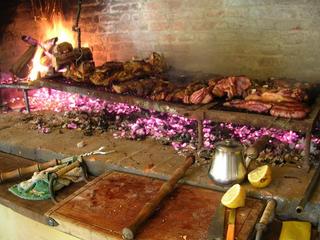
Barbecue, or "asado" as we call it's the national dish, if there's such a thing. Uruguay's meat has very good fame, and for good reason. The conditions for cattle growing are ideal in this part of the world, or so they say. History goes that, a long time ago (in this galaxy;), one spanish guy, called Hernandarias, brought around 100 cattle heads to the land, that would later become Uruguay, and in a matter of years they had reproduced big time. Land and weather natural conditions turned out to be real good, as well as the lack of any kind of predators, including human populations. So we could say that Uruguay's territory was populated extensively first by cattle, then by humans.
Asados are social activities, instead of charcoal the meat is roasted by making a fire from wood, and using the embers (is that the word?) to cook the meat. It's a time consuming process, but all for the better, because while someone is preparing the fire (el asador) everyone else get's to eat snacks, and play cards ("truco" typically). It's typical to put some parmesano provolone cheese on the grill, and to serve hot cheese as entrance, along with the snacks. The meat is placed in a big, big grill, called "parrilla", expected to support considerable amounts of meat, and sausages ("chorizos").
Typically if the asado turns out to be good, the responsible cooker (el asador), get's an applause from everyone. Actually "el asador" always gets an applause, unless the asado is real bad, and you have a trust relationship with the person so you can tell him the awfull truth, that his asado sucks. Luckily this is not often.
...
Posted by
gabouy
at
6:28 PM
43
comments
![]()
Wednesday, October 05, 2005
Mate
<<previous
next>>

Mate is the name of a typical beverage of the river plate zone, shared with south of brazil and argentinians. It's an infusion of a weed named "yerba" (wich actually in spanish means weed), like tea, but the weird thing is that it is drinked (sipped actually) in a special recipients made out of a dried, hollow "fruit" (it's kinda small pumpking) called mate, wich names the whole thing. You sip it with a metal thing called "bombilla". There I've said it. It's like coffe, some sort of stimulator, very popular among students to start the day, and to stay awake until late.

Half of the population or more are on it, people carry their own "mates" to work, and it's also a social drink, it's unpolite to have mate and not offer, and if someone requests "a mate", while you are having it's almost illegal to deny it.
...
Posted by
gabouy
at
8:57 PM
37
comments
![]()

